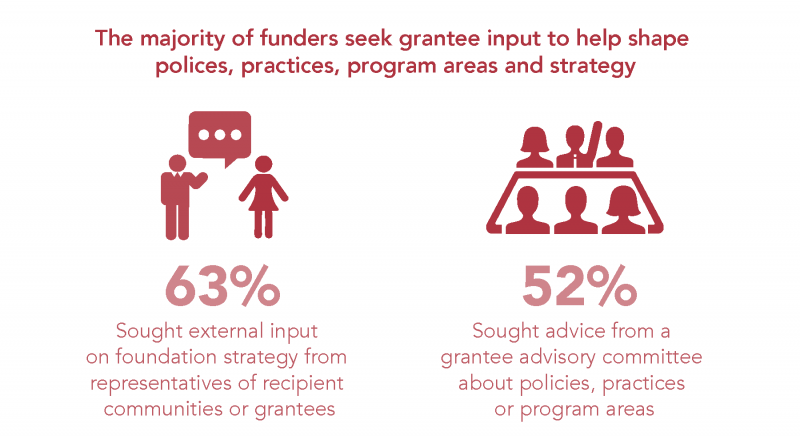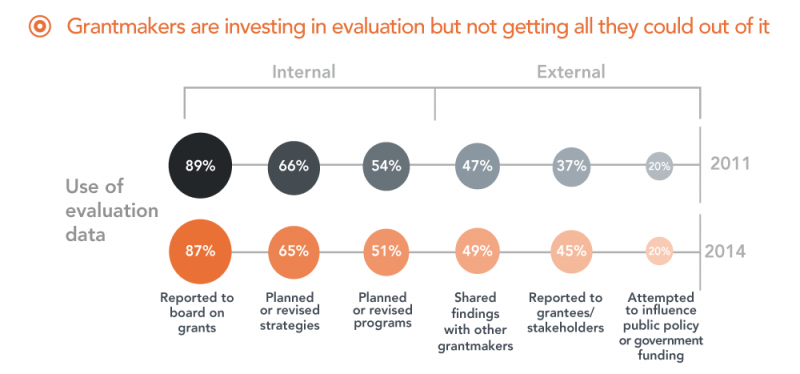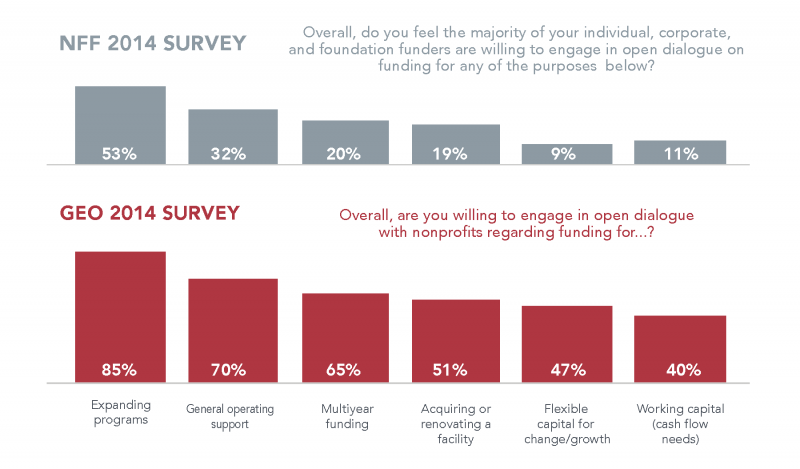Findings from a national study
The five conditions for collective impact offer guidance not only for collective impact initiatives but for other forms of collaboration as well. In an effort to see more effective collaborations happening among grantmakers and grantees and across communities, Grantmakers for Effective Organizations advocates for changes in grantmaking practice that better support collaboration. Our hope is that more grantmakers will adopt practices conducive to collaboration, and many of the practices GEO advocates are aligned with the five conditions of collective impact — common agenda, shared measurement, mutually reinforcing activities, continuous communication and strong backbone.
Every three years, GEO conducts a national survey of staffed foundations to track progress on practices that both grantmakers and nonprofits agree are critical to achieving better results. We have a keen interest in understanding the extent to which grantmakers embrace the attitudes and practices we know are essential for collaboration because without the right kind of support collaborations won’t have the resources they need to survive and thrive.
The data from GEO’s 2014 field study show more grantmakers are adopting practices that are aligned with some of the conditions for collective impact, but in a couple of areas the data suggest more progress is needed.
1. Common Agenda — coming together to collectively define the problem and shape the solution
Let’s face it, foundations don’t typically have a reputation for being open and collaborative when it comes to setting strategy. Adopting a common agenda in partnership with a cross-sector range of organizations would be a radical shift for many foundations. The good news is an increasing number of grantmakers recognize the need for grantee input to inform policies, practices, program areas and strategy. In fact, the majority of funders seek input and advice from grantees, and, as the table below shows, this number has grown significantly in the past three years. This movement is a step in the right direction toward more grantmakers being comfortable with co-creating a common agenda.

2. Shared Measurement — agreeing to track progress in the same way, which allows for continuous improvement.
Grantmakers and nonprofits alike want to know if our work is making a difference and how we can improve our work over time. Three-quarters of grantmakers in our survey evaluate their work, an all-time high since our survey began 10 years ago. However, the data suggest that grantmakers for the most part are not using evaluation in a way that is conducive to the shared learning and continuous improvement that is critical for effective collaboration.

From these findings, it is clear that grantmakers are using data primarily for internal purposes, such as informing internal strategy and communicating with the board. Less than half of grantmakers are sharing what they’re learning with others, such as grantees, community members or policymakers. Not only does keeping this data for internal eyes only present a missed opportunity for learning and improvement outside the walls of the foundation, it also suggests the field still has significant work to do to get the majority of foundations to buy into shared measurement.
3. Mutually Reinforcing Activities — coordinating collective efforts to maximize the end result.
Grantmakers recognize that far greater impact is achieved by working with others rather than alone. Eighty percent of survey respondents said it was important to coordinate resources with other grantmakers working on similar issues, a practice which can support aligning funding to support a collaborative’s common agenda. And better yet, most of these grantmakers are walking the talk. The majority (69 percent) developed a strategic relationship with other funders in the past two years, with the primary reason for doing so being to achieve greater impact (99 percent).
4. Continuous Communications — building trust and relationships among all participants.
Recognizing that Money = power, the onus is on grantmakers to work proactively to build trusting, open relationships with grantees and other stakeholders. Results from GEO’s survey show that funders are increasingly seeking feedback (anonymous or nonanonymous) from grantees — 53 percent report doing so in 2014, up from 44 percent in 2011. This, plus the growth in grantmakers seeking input mentioned above, suggest that more grantmakers are taking deliberate steps to build strong relationships with grantees.
However, data from GEO’s field survey and a Nonprofit Finance Fund study suggest a gap in perception between nonprofits and grantmakers about how open grantmakers really are. Nonprofit Finance Fund, in a recent survey, asked nonprofits if the majority of their funders were willing to engage in open dialogue on a range of key financial issues. In GEO’s survey, we asked grantmakers if they were open to discuss the same issues with their grantees. As the table below shows, we found a sizeable gap between nonprofits’ perception of openness and how open grantmakers say they are.

These findings raise the question: Are grantmakers overly confident about how well they build trust and relationships with grantees and other stakeholders? One way to test this is to solicit anonymous feedback from grantees; our survey found that only about one-third (34 percent) of grantmakers currently do so.
5. Strong Backbone — having a team dedicated to orchestrating the work of the group.
Collective impact initiatives have a dedicated backbone, and all forms of collaboration require some level of infrastructure and coordination. These things cost money. A key way grantmakers can support collaboration among nonprofits is by supporting this backbone or infrastructure.
GEO’s survey findings present somewhat of a mixed bag when it comes to grantmaker support for a strong backbone. Unfortunately, the majority of grantmakers (53 percent) say they rarely or never support the costs of collaboration.
Grantmakers could benefit from more education and advocacy about the importance of supporting the costs of collaboration. On the brighter side, among those grantmakers that do support collaboration, 72 percent say they fund the infrastructure or operational costs of collaboration.

How Are We Doing?
So how well do grantmaking practices align with the conditions of collective impact? For the most part, GEO’s survey shows that grantmakers have made significant progress over the years in practices that are aligned with a common agenda, mutually reinforcing activities, and continuous communications. However, there is still room for improvement. The field needs more funding for the backbone and infrastructure required to keep collaborations running. Grantmakers conducting evaluations primarily for internal audiences are missing a great opportunity for field-building learning and improvement. And while grantmakers by and large are making efforts to build strong and trusting relationships with their grantees, grantmakers and nonprofits seem to have mixed perceptions about how well those efforts are working.
Grantmakers are often key catalysts of collective impact efforts, so it is important to see alignment between grantmaker practices and the conditions of success. While GEO’s study shows areas of progress worth celebrating, the data also highlight a need for further education and advocacy for ways grantmakers can both be more collaborative — such as in buying into a common agenda and shared measurement or building trusting relationships with grantees and stakeholders — and better support collaboration by funding the costs of a backbone or infrastructure. Our hope is that as organizations like GEO, Collective Impact Forum, and others continue to reinforce the importance of these practices, we will see further progress from grantmakers in our next field study in 2017.
Question for Forum members: How does your experience compare with our findings above? Please share with us your thoughts in the comments.
To read more about GEO’s 2014 study, Is Grantmaking Getting Smarter?, click here.
